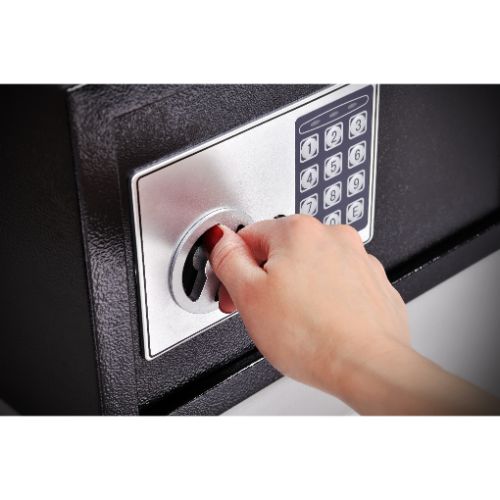Gun safes exist to keep your firearms safe and away from people you don’t want to access. So, it makes sense to assume that they would be airtight because that would mean that they’re also as secure as possible, right?
While this certainly isn’t flawed logic, the truth is gun safes are not airtight. And in this article, we’ll be looking at why exactly they aren’t airtight and some other safety concerns you should look for in your gun safe.
Read on for more information about whether or not gun safes are airtight. Let’s get right to it to find out!
Why Gun Safes Are Not Airtight
There is a straightforward reason why gun safes are not airtight, and it has to do with the fact that there are holes throughout the safe – holes that serve an essential purpose. They allow for some airflow throughout the safe as air moves in and out of the safe through the holes.
This also means that the safe is not waterproof and is partly why most safes are not fireproof. But there is more to it than this.
Where are these holes?
Considering that gun safes are no more than giant steel boxes, it’s pretty surprising just how many holes there are in them. Here are some of the main areas where you’ll find holes in your gun safe.
Bolt-down holes – This is not a central place for air to escape since most gun safes are bolted to the ground. However, bolt-down holes can be found on pretty much every safe in the world.
Door seam – This is a pretty obvious place and the main area where air passes in and out of the safe. However, there is a way to test how much air is escaping through your safe’s door seam. If it takes a while for the door to close, and you have to push on the door to close it completely, then it’s relatively airtight. However, it’s not very airtight if it closes with a clunk.
Dehumidifier hole – A dehumidifier hole exists due to how little airflow there is on a gun safe, despite how many holes there are. Because of this lack of airflow, humidity in the air will settle down onto anything you’re storing in the safe. But with a dehumidifier, the safe’s interior will stay warm enough that humidity won’t settle onto your essential belongings.
Wall mounting hole – This hole doesn’t exist on many safes, and the safes that do have it are usually ones found in cabinets. Wall mount holes are found at the top back of the safe and are there to bolt into the studs of a wall. This will prevent the safe from falling forward.
What to Look For in a Gun Safe
It would be best to look for a few things when you are on the hunt for a new gun safe. Here are some of the essential features.
Relockers
It’s all well and good to have a high-quality lock, to begin with, but even the best gun safe locks on the planet can be defeated if a thief is determined enough. This is why it is crucial to invest in a relocker.
Essentially, a relocker is a fail-safe measurement that engages in the event that your gun safe’s lock has been compromised. If your lock is destroyed, the relocker will kick into gear and keep the safe locked so that, even if the intruder completely removes the lock, the bolts or bars of the safe will not disengage.
You’ll find two lockers on the market: internal relockers and external relockers. Ideally, your safe will have both, but you should never consider a safe that doesn’t have either.
UL-Listed Locks
As we mentioned earlier, the lock is the core of your gun safe and you’re going to need a good one if you want to keep intruders away. The best locks on the market are those with a UL listing, which means that they have been tested and certified by Underwriters Laboratories.
UL is an organization regarded as the gold standard for reliability and safety testing. These locks meet the rigorous requirements that the company sets out and will be able to keep your firearms and other valuables safe.
Fireboard
If you’re like most people, you didn’t buy a gun safe just to protect your firearms from thieves. Another primary reason to purchase a gun safe for your home is to protect your other valuables in the event of a fire, so you might want to consider a safe that has fireboarding.
Fireboard layers are installed on the door, floor, walls, and ceiling of the safe, and the more layers, the more protected your gun safe will be against fire. Be wary, though – unlike locks, there is no UL testing process or standard system for testing fire ratings.
As such, several brands will exaggerate their fire ratings to make their safes seem, well, safer. They might list a temperature resistance or fire resistance time that their safe cannot withstand.
Multi-directional Protection
The most basic safe designs only feature locking bars or bolts at the side of the door, opposite the hinges. If an intruder can pry the door past these initial bars or bolts, they’ll have total access to your safe.
More advanced safe designed feature bolts on the top and bottom, which provides them with further protection against pry attacks. The best designs will also feature bolts on the hinge side, which provides protection for that side.
Final Thoughts
So as you can see from the information, gun safes aren’t airtight and there is a good reason for this too. It is vital that your firearms and ammunition have a safe space to be stored that has healthy airflow so moisture does not build up. Ensure that the safe you purchase has good ventilation to avoid problems with rust, corrosion, and safety issues that could come from a stuffy, moist gun safe.


